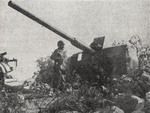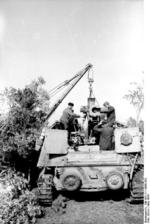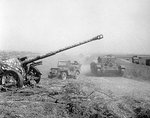8.8 cm FlaK 41 Anti-Aircraft Gun
| Country of Origin | Germany |
| Type | Anti-Aircraft Gun |
| Caliber | 88.000 mm |
| Weight | 7800.000 kg |
| Ammunition Weight | 9.40 kg |
| Rate of Fire | 20 rounds/min |
| Ceiling | 11.300 km |
| Muzzle Velocity | 1,000 m/s |
Contributor: C. Peter Chen
ww2dbaseWhile the predecessor FlaK 18/36/37 anti-aircraft guns were very successful especially considering its versatility of being great anti-tank weapons as well, in their intended anti-aircraft role they could not reach the high altitude that Allied bombers were able to operate. In 1939, the German air force Luftwaffe issued the request for a new anti-aircraft design that also made use of the same 8.8-centimeter shells. Rheinmetall responded with a new design that, aside from an increased effective ceiling of 11,300 meters (max 15,000 meters), they also had a lower silhouette for better protective particularly in the field. The high cost, largely due to the design's complexity, kept them from being produced in great numbers, however; only 279 were built by Feb 1944, and just another 277 by the end of the war. In North African service, FlaK 41 guns were prone to jam in the desert climate, thus most of them were withdrawn back to Germany where they could be regularly serviced by engineers. In Jan 1945, 318 FlaK 41 guns were reported to be in active service by the German military.Krupp also developed a design as an answer to the 1939 Luftwaffe request. Although it was not chosen, Krupp's 8.8 cm Gerät 42 design was developed into the very effective 8.8 cm PaK 43 anti-tank design. The design was also modified to produce the 8.8 cm KwK 43 tank guns that equipped the Tiger II heavy tanks, Nashorn tank destroyers, and Jagdpanther tank destroyers later in the war. As anti-tank weapons, these Krupp-built 8.8-centimeter guns were able to penetrate 200-millimeter of armor at the range of 1,000 meters.
Informally, all 8.8 cm FlaK guns (including the FlaK 18/36/37 predecessors) were known by the German military as Acht-acht, 8-8.
Source: Wikipedia. ww2dbase
Last Major Revision: Apr 2010
Photographs
 |  |  |
Você gostou deste artigo ou achou este artigo útil? Se sim, considere nos apoiar no Patreon. Qualquer valor já vai ajudar! Obrigado. Por favor, ajude-nos a divulgar o site: Fique atualizado com WW2DB: |
Visitor Submitted Comments
All visitor submitted comments are opinions of those making the submissions and do not reflect views of WW2DB.

- » Wreck of Teruzuki Found (27 jul 2025)
- » USS Orlean's Bow Found (22 jul 2025)
- » The Emperor of Japan Planned to Honor WW2-era Japanese POWs in Mongolia (4 jul 2025)
- » US State Lawmaker John Winter Caught Using Racial Slur "Jap" and Apologized (11 jun 2025)
- » US Government Plans to Purge WW2 Information (17 mar 2025)
- » Ver todas as notícias
 |
- » 1,182 biografias
- » 337 eventos
- » 45,119 entradas na linha do tempo
- » 1,248 navios
- » 350 modelos de aeronaves
- » 207 modelos de veículos
- » 376 modelos de armas
- » 123 documentos históricos
- » 261 instalações
- » 470 resenhas de livros
- » 28,410 fotos
- » 365 mapas
Lt. Gen. Lewis B. "Chesty" Puller, at Guadalcanal
Por favor, considere nos apoiar no Patreon. Mesmo R$1 por mês já faz uma grande diferença. Obrigado!
Ou, por favor, nos apoie adquirindo alguns produtos do WW2DB na TeeSpring. Obrigado!
22 Sep 2010 06:32:51 AM
cool....
german artillery would be next to none...